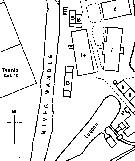
After I came off screen printing I was sent down to the Dye House to work as assistant to `Curly' Simpson (he had curly hair) who was in charge. There were already two other boys, Fred Bull and Joe Frost, and I was a bit surprised to find Sid Allen working there, which suggests screen printing had closed down. The Dye House was one of a group of ancillary buildings at the extreme south end of the works divided by a half-open half-covered yard. It was on the west side with a small laboratory north of it. The Laboratory was in the open part and was where Curly Simpson prepared his dyes and other mixtures. He kept swatches of colour-dyed silks in various shades in reference books. A pair of wide wooden doors led to the covered part of the yard and the entrance to the Dye House. In some respects the Dye House had a similarity to the Long Shop, wide with a highcentred roof coming down low at the sides, but whereas the Long Shop had large semi-circular windowed ends the Dye House had large two-thirds circle windowed ends. To the west was a pump house and two large water storage tanks, the water being taken from a lagoon itself filled by an aqueduct from the river. The water would have been treated before use.
| [Full size image 95.8kb] |
The metal dye vats had a vertical front and a bottom that sloped up in a semi-circle towards the rear supported by a frame. Inside the front end was a piped steam jet which heated the water. The operator stood on a raised duckboard platform at the rear facing a fixed spaced pair of glazed earthenware grommets and a revolving belt-driven slatted drum. The vat was filled with a measured quantity of water heated by the steam and the dye stirred in. The silk was passed through the grommet, over and round the drum and the end corners tied to form a continuous loop. The belt drive, which was powered from an electric motor-driven rotating shaft, had a shift mechanism which brought it from idling to drive so turning the silk over the drum. The grommets kept the silk from wandering as two pieces could be done side by side. From time to time the machine was stopped briefly so that Curly Simpson could take a small snippet of silk for a check with his swatches. Panic ensued if the silk became untied, but more often the silk got bundled up and jammed under the grommet. The machine had to be stopped and the cause remedied quickly else the silk would be spoiled. The vat was also used simply for washing purposes using soda ash, a gooey substance taken from bound plywood drums. After the various bleaching, dyeing, washing and rinsing processes the silks were taken to the drying room, of which more later. It was not unusual to play jokes on each other by putting dollops of soda ash in rubber boots before leaving.
The large, long backing washing machine was divided inside into a number of compartments, or tanks, with a series of rollers top and bottom and was used to wash clean the soiled backing. Backing came in assorted lengths all stitched carefully together but could be separated at convenient points when used for mounting silks, and had to be fastened again for the washing process. The backing had initially to be threaded in and out of each of the tanks and a long length was always kept in situ overnight. The tanks were filled about three-quarters full with heated water and the backing passed slowly from one tank to another, then over a bank of steam-heated cylinders before being rolled up and taken to the Long Shop for reuse. Sid Allen was in charge and I think he called the machine `Trixie'. He collected up the used backing from the Steam House.
The south boundary of the works had a narrow culvert of water controlled by a sluice from the river. The water passed under an outshut at the end of the covered part of the yard. It was here a boy wearing rubber boots and apron was employed to wash the used sieves, clothes and brushes collected up from the printers and was responsible for their distribution. Many boys had severally had the job including one I know only as Frankie.
Postscript
At the time of writing the works has undergone a dramatic transformation. It is now described as the Merton Abbey Mills. The former workshops have long since ceased their original function. The ancillary buildings, boiler house, steam house and dye house have been demolished and the lagoon filled in to become a car park. Offices, shops, craft stalls, a tea room, restaurant and public house have taken over. It is noisy at weekends with the bustle of traders, entertainers and visitors. I would much prefer to remember the Liberty Silk Printing Works as it was. The neat lawns with chain-link fencing down the middle of the yard, the shrubberies outside the workshops, the sound of birds in the wall creepers, the faint dull thump of printers' mauls on the blocks indicating the process of producing beautiful fabrics for the Regent Street shop. And how very peaceful it all seemed in the harshness of war.
From, Local History Notes No 8 - ‘Liberty Print Works - Wartime Remembrances' by W J Rudd - 1993 Published by Merton Historical Society - September 1994 For further details of the Society, contact the Secretary at 100, Cannon Hill Lane, SW20 9ET
|
|
|
|